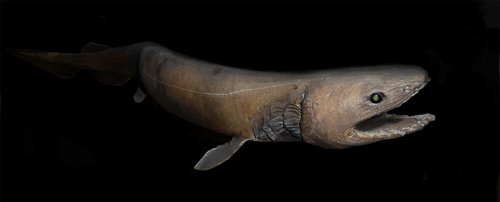
Frilled Shark
The Atlantic bluefin tuna (*Thunnus thynnus*) is a highly migratory, predatory fish renowned for its size, speed, and commercial value. It plays a crucial role in the marine ecosystem and has been a prized catch for centuries.
10 25 years
Lifespan
150 - 200 cm
Length
Near Threatened
Conservation Status
Unknown km/h
Swimming speed
Carnivorous
Diet
Local Migration
Migration
Appearance Overview
The Atlantic bluefin tuna is a large, torpedo-shaped fish with a metallic blue-black back and a silvery-white belly.
Coloration
Dark metallic blue on top with a silvery underside
Body Shape
Torpedo-shaped, streamlined for speed
Fins
Two dorsal fins, the first depressible; small finlets behind second dorsal and anal fin
Keel
Strong lateral keel on the caudal peduncle
Length
Up to 13 feet (4 meters), commonly around 6.5 feet (2 meters)
Weight
Up to 2,000 lbs (900 kg), commonly around 550 lbs (250 kg)
Diet
Carnivorous, feeding on a variety of fish (such as herring, mackerel, and hake), squid, and crustaceans.
Feeding Behavior
Highly active predator, often hunting cooperatively in schools. They use their speed and agility to chase down prey, sometimes pushing baitfish to the surface.
Social Behavior
Highly migratory, forming large schools, especially during spawning. Schools can be segregated by size.
Commercial Relevance
Extremely high value, particularly in the sushi and sashimi markets of Japan. A single fish can be worth tens or even hundreds of thousands of dollars.
Conservation measures
Strict fishing quotas, minimum size limits, time/area closures, and international agreements (e.g., ICCAT) are in place. Efforts to reduce bycatch and improve data collection are ongoing.
Status
Eastern Atlantic stock: Least Concern; Western Atlantic stock: Endangered; Southern bluefin tuna: Critically Endangered
Threats
Overfishing (historically and, in some areas, ongoing), illegal and unreported fishing, bycatch in other fisheries, and climate change (potentially affecting prey distribution and spawning grounds).
Habitat Distribution
Depth Range
0-1,000 meters (0-3,280 feet), but most commonly found in the upper 200 meters (656 feet)
Geographic Range
Western and Eastern Atlantic Ocean, Mediterranean Sea, and formerly in the Black Sea.
Preferred Environment
Temperate and subtropical waters, pelagic (open ocean), often near continental shelves and slopes.
Reproduction and Life Cycle
Breeding Habits
Spawns in warm waters, primarily in the Mediterranean Sea and the Gulf of Mexico. Spawning occurs in large aggregations.
Development Stages
Eggs are pelagic (free-floating). Larvae develop rapidly, feeding on plankton. Juveniles grow quickly, forming schools and migrating long distances.
Fecundity
Females can produce a large number of eggs, with larger females producing up to 30 million eggs per season.
Maturity Age
Matures at 4-8 years in the Eastern Atlantic and Mediterranean, and around 8-12 years in the Western Atlantic.
Faqs about Frilled Shark
Where can I find Atlantic bluefin tuna?
Atlantic bluefin tuna are found in both the western and eastern Atlantic Ocean, as well as the Mediterranean Sea.
How long do Atlantic bluefin tuna live?
Atlantic bluefin tuna can live up to 40 years.
What is the biggest threat to Atlantic bluefin tuna?
The biggest threat is overfishing, which has severely depleted their populations in the past.
Are Atlantic bluefin tuna endangered?
Yes, but it depends on the population. The western Atlantic population is endangered, while the eastern Atlantic population has shown signs of recovery due to strict management.
Are Atlantic bluefin tuna warm-blooded?
They are warm-blooded, which allows them to maintain a higher body temperature than the surrounding water, giving them advantages in speed and endurance.
How fast can Atlantic Bluefin Tuna swim?
They can swim at speeds of up to 43 mph (70 km/h) in short bursts.
What are the natural predators of Atlantic bluefin tuna?
Atlantic bluefin tuna are apex predators, meaning they are at the top of the food chain and have few natural predators other than orcas and some large sharks when young.
Copyright @ Nature Style Limited. All Rights Reserved.
 English
English